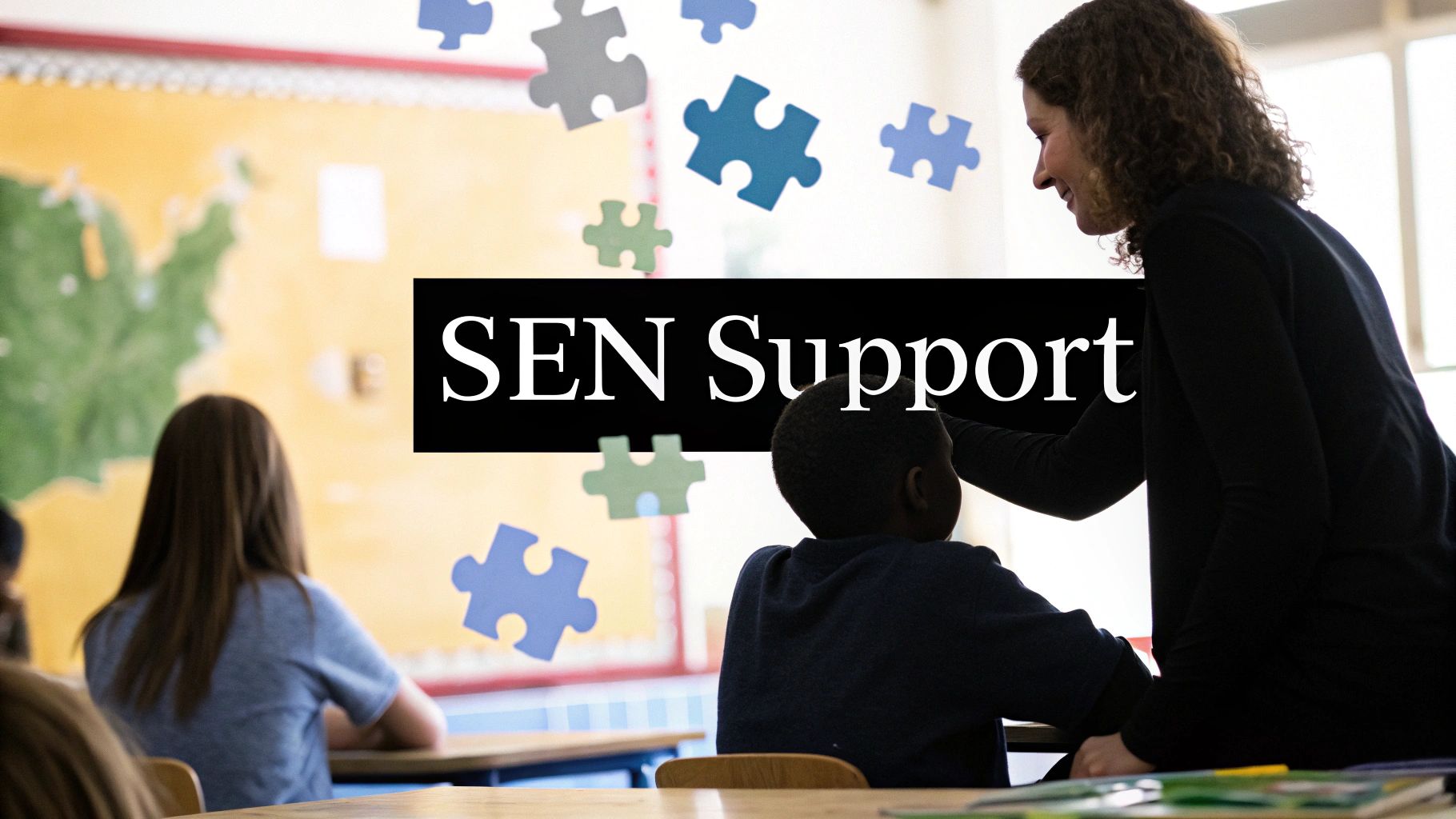At its heart, SEN support is the promise of extra help your child receives at school when they need something different from or additional to what their classmates get to help them learn and progress. It isn't a label, but a recognition that every child's journey is unique. It's about seeing your child, understanding their struggles, and giving them the tools they need to shine.
Unpacking The Meaning of SEN Support
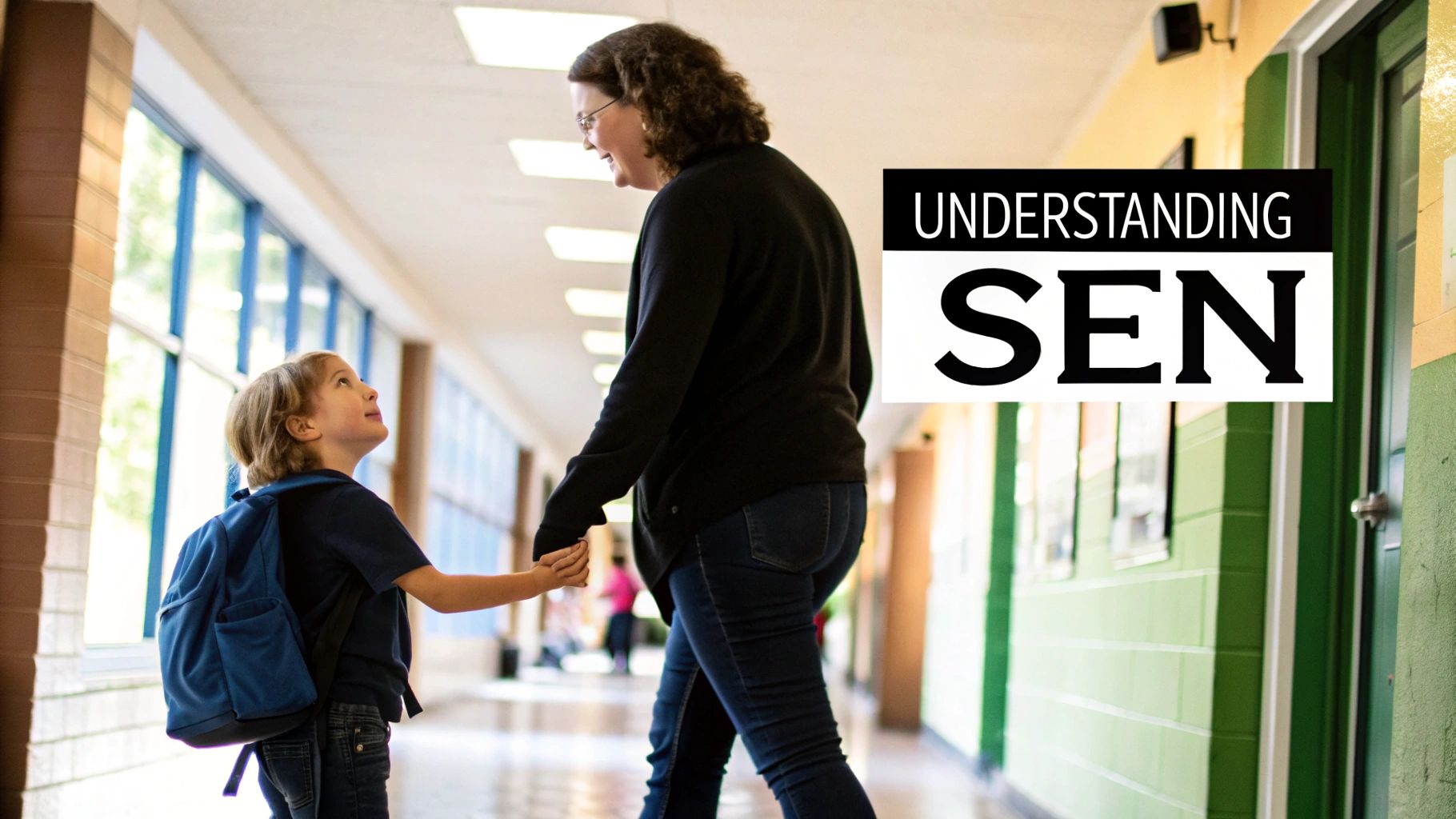
That initial worry—the feeling that your child might be struggling more than their friends—can be a lonely and confusing experience. But understanding what SEN support actually is can replace that uncertainty with clarity and confidence. It’s the practical, day-to-day assistance organised by the school to help your child overcome their barriers to learning. This is a collaborative journey, one where you, your child, and the school work together as a team.
Special Educational Needs (SEN) simply means a child has a learning difficulty or disability that makes it harder for them to learn than most children their age. This can feel different for every child.
Real-World Examples of Needs
- Communication: Imagine a child who knows exactly what they want to say, but the words just won't come out in the right order. Or a child who smiles and nods in class, but struggles to follow what the teacher is explaining.
- Social and Emotional: This could be a child who finds the playground overwhelming and prefers to be alone, or one whose anxiety makes it hard to leave your side at the school gates.
- Cognition and Learning: This might look like a bright, creative child who loves stories but whose reading is slow and difficult (dyslexia), or one who panics when faced with a page of numbers (dyscalculia).
- Sensory or Physical Needs: It could be a child with a visual impairment who needs larger print, or one with a physical disability who requires special equipment to join in with PE.
The support provided is always centred on the individual child. For one student, it might be using visual timetables to reduce the anxiety of not knowing what's next. For another, it could mean having a teaching assistant provide extra help with phonics in a quiet corner. The goal is always to create an environment where your child feels capable and understood. To learn more about this approach, you can explore the principles behind what is an inclusive education.
The right question isn't “why so many diagnoses now?” but “why were needs ignored for so long?” Recognition is overdue, not excessive. The focus should be on adjusting the system to reflect the diversity of minds it serves.
This support is a fundamental part of a school's responsibility. To see how these principles are applied in practice, you might find valuable insights in this case study on supporting young adults with learning difficulties and autism.
Recognising the Signs Your Child May Need Help
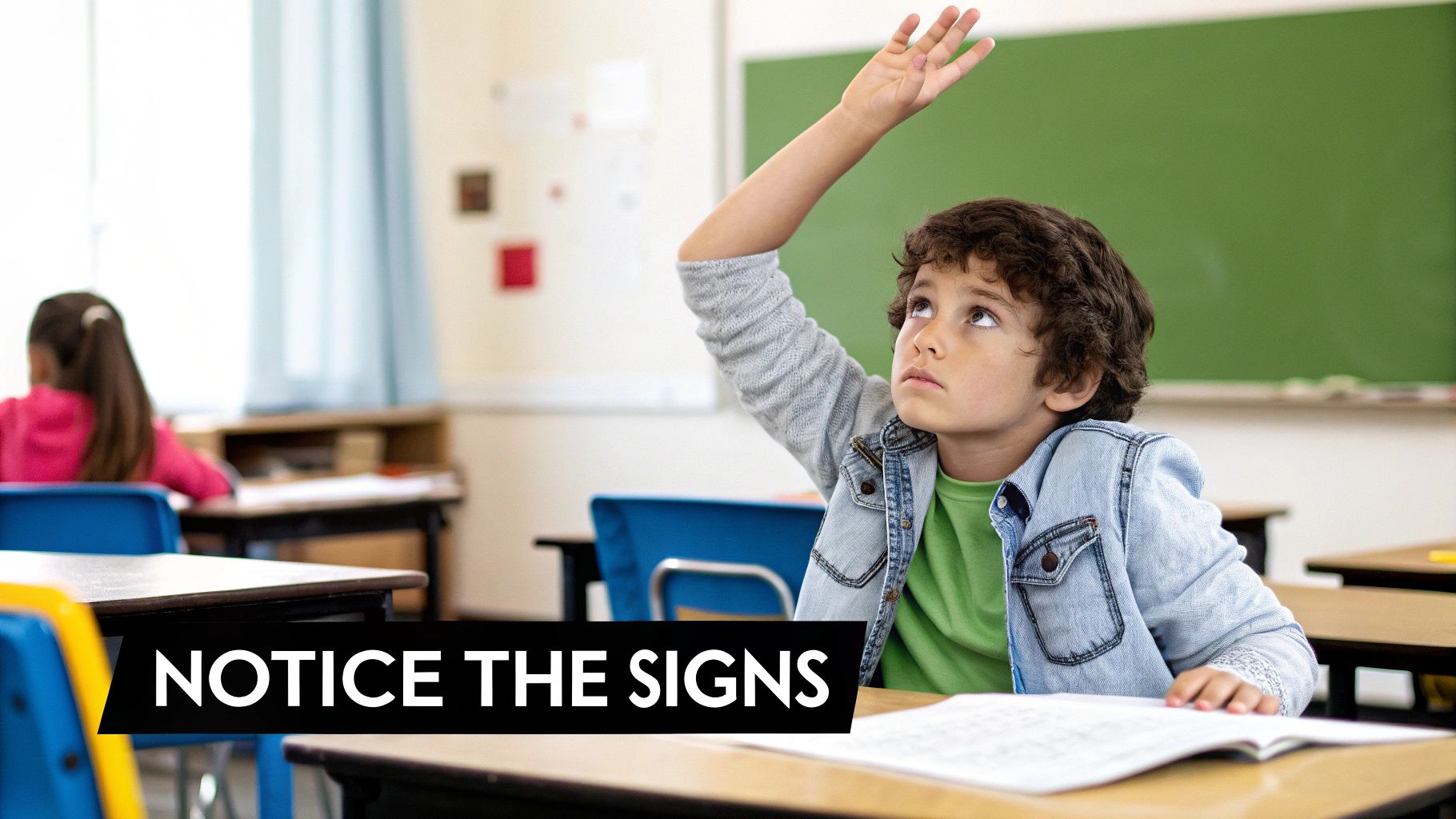
As a parent, you have an instinct. A quiet feeling that something isn’t quite right with your child’s experience at school. It’s a powerful intuition, and it’s worth listening to. Recognising that your child might need extra support isn’t just about grades; it’s about noticing the emotional effort it takes for them to get through each day.
Trusting that feeling is always the first step. You are the expert on your child. This isn’t about jumping to a diagnosis. It’s simply about paying attention to the small, everyday hurdles that might suggest they need a bit more help to feel happy and successful in their learning.
Observing Beyond the Report Card
The clues that a child might benefit from SEN support are often subtle and show up in their emotions and behaviour long before they appear in a report card. To really see what’s going on, you have to look at the whole picture of your child, not just their academic performance.
Think about the bigger pattern. Does your child consistently struggle with things their peers seem to handle with ease? Before approaching a school, it helps to truly understand your child's learning behavior and profile.
Here are a few real-world examples that might feel familiar:
- Emotional Outbursts: Does your child come home from school and immediately have a meltdown over something small? This can be a sign they've been holding in stress and anxiety all day.
- Social Struggles: Maybe they find it hard to make friends, constantly misread social cues, or tell you that "no one played with me today" so often that it breaks your heart.
- Sensory Overload: They might feel completely overwhelmed by the loud school bell, bright classroom lights, or even the scratchy texture of their uniform, making it hard to focus on anything else.
- School Avoidance: This can look like a deep-seated fear of reading aloud, a flat-out refusal to do homework, or complaining of a stomach ache every morning before school.
- Memory and Organisation: Are they constantly losing their PE kit, forgetting instructions moments after you’ve given them, or is their school bag a jumble of crumpled papers and forgotten lunch boxes?
Every child’s journey is unique. The goal is not to compare but to understand. Your observations provide the context that teachers need to see the child behind the behaviour.
How to Talk About Your Concerns
When you decide it’s time to speak with the school, having specific examples ready makes all the difference. It helps turn a feeling of worry into a productive conversation about your child.
Instead of saying, "I think he's struggling socially," you can say, "I've noticed he hasn't been invited to any birthday parties this year, and he told me the other children call his games 'weird'."
This kind of detail helps the school see the patterns you’re seeing through your child's eyes. It turns a general worry into a clear, concrete starting point for a collaborative discussion. Your perspective is the crucial first piece of the puzzle in building the right support system for your child.
How the Graduated Approach Works in Practice
So, what happens when a school has a concern about a child's progress? They don’t just jump to conclusions or apply a one-size-fits-all solution. Instead, they start a thoughtful, collaborative process called the graduated approach. It might sound a bit technical, but its heart is really simple: it’s a continuous cycle of support built around your child.
This isn’t about fitting your child into a pre-made box. Think of it as a responsive partnership between you, your child, and the school, ensuring any support is flexible, effective, and always puts your child's well-being first.
And this kind of partnership is needed more than ever. In England, recent statistics show that over 1.7 million pupils have an identified SEN need. That figure has shot up by 29.5% since 2016, which shows just how vital it is for our schools to recognise and adapt to a huge diversity of learning needs. You can read more about the latest SEN statistics in England to get the full picture.
This process flow shows the simple, continuous cycle of support.
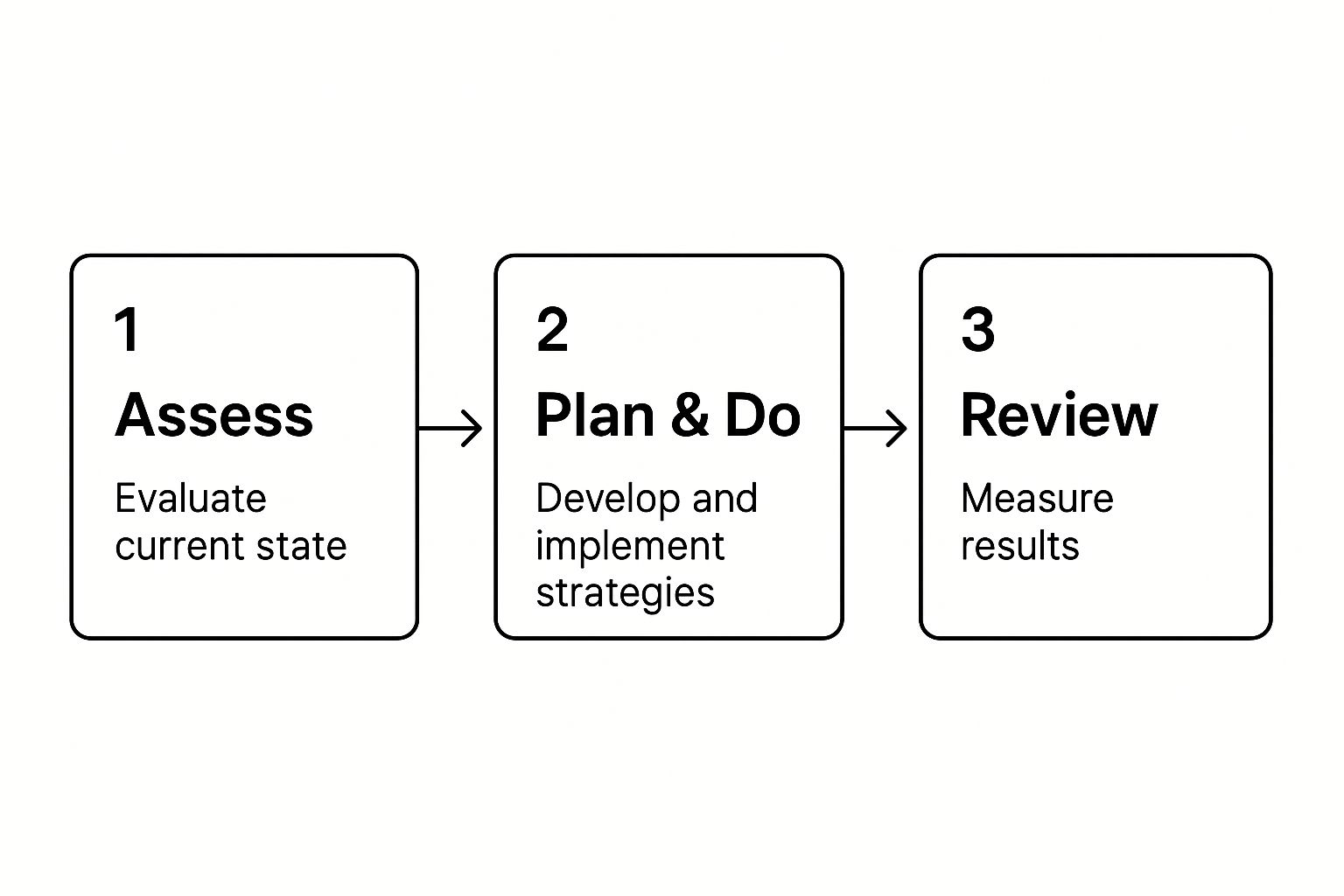
As the infographic shows, SEN support isn't a one-time fix. It’s an ongoing, adaptive journey for your child.
The Four Stages of Support
The graduated approach unfolds in four clear, connected stages. It's less of a rigid checklist and more like an evolving conversation—a cycle of listening, trying, and learning together to discover what works for your child.
-
Assess: This is the starting point. It’s where the teacher, the school’s SEN coordinator (SENCO), you, and—most importantly—your child come together. Everyone shares observations to pinpoint the specific barriers getting in the way. For a child with dyslexia, this might be identifying their struggle with decoding words. For a child with anxiety, it could be noticing their fear of speaking up in class.
-
Plan: Once the need is understood, the team creates a plan for your child. This is where practical, targeted strategies are decided. It’s not about pulling generic solutions off a shelf; it's about personalised adjustments. For example, the plan for a child who struggles with concentration might include short movement breaks and a seat away from distractions. This process is a great example of what is scaffolding in education, where support is layered to help a child climb higher.
-
Do: This stage is all about action. The teacher puts the agreed-upon strategies into practice. For a child who finds writing difficult, this could mean allowing them to use a laptop. For a student with ADHD, it might be providing a 'wobble cushion' to help them focus. It's about finding what helps your child engage happily in their learning.
-
Review: After a set period, everyone comes back together to check in. What’s working for your child? What isn’t? The feeling of relief when a strategy finally clicks is immense, but it's just as vital to acknowledge when something isn't helping. This review ensures the support adapts as your child’s needs change, making the whole system truly responsive to them.
The real power of the graduated approach lies in its cyclical nature. It’s a promise that the school will keep listening, keep trying, and keep adjusting until they find the right key to unlock your child’s potential. It replaces guesswork with a thoughtful, evidence-based partnership.
What SEN Support Looks Like in the Classroom
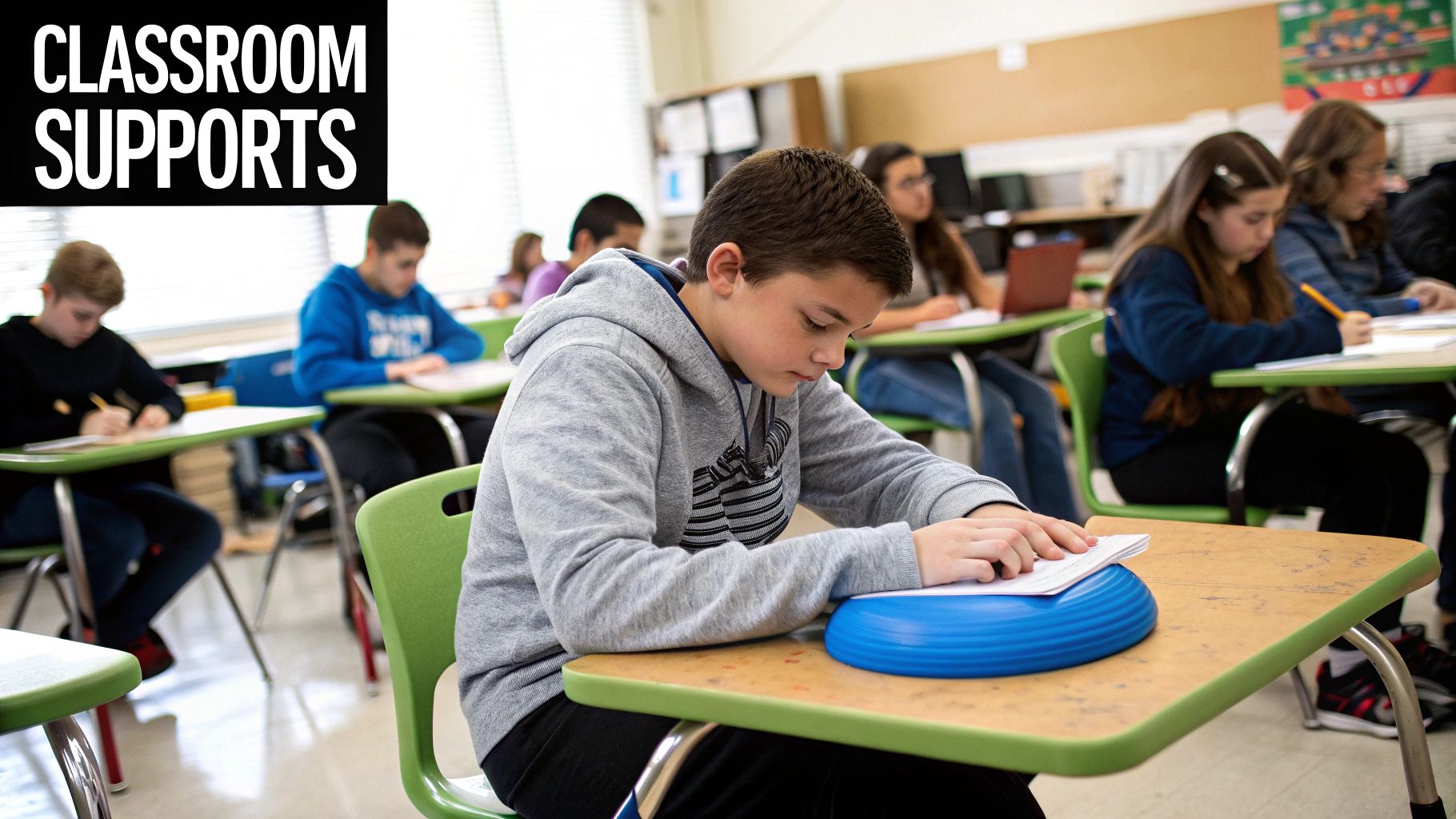
Moving from the process to the playground, what does SEN support actually look and feel like for your child every day? It’s rarely about grand gestures. Instead, it’s a collection of small, thoughtful adjustments that build a bridge between your child and their learning.
These changes help them feel capable, understood, and successful, transforming the classroom from a place of anxiety into a space of opportunity.
Imagine a child with ADHD who finds it almost impossible to sit still. Their teacher might provide a ‘wobble cushion’—an inflatable disc that lets them move gently at their desk without disrupting others. For that child, this simple tool means they can finally focus on the lesson instead of fighting an overwhelming urge to fidget.
This isn’t about making things ‘easier’; it’s about making them accessible. These are tools, not crutches, designed to level the playing field so every child has a fair chance to participate and learn.
Personalised Tools for Learning
The beauty of SEN support lies in its personalisation for each child. For a child with dyslexia, reading a block of black text on a white page can feel like the words are swimming. A simple coloured overlay, a thin sheet of tinted plastic placed over the page, can calm the text and make it instantly more manageable for them.
This approach is at the heart of effective teaching. By understanding the specific barrier a child faces, educators can provide the right support. This concept is explored further when you consider what is differentiated learning, a strategy that tailors instruction to meet individual needs.
These practical examples show how SEN support translates into real-world help for a child:
- For Communication Needs: A teacher might pre-teach key vocabulary to a child with language processing difficulties before a new topic begins. This gives them the confidence to join in discussions because they already have the words they need.
- For Social and Emotional Needs: A student who feels overwhelmed by the noise and chaos of break time might benefit from a ‘buddy system’ or access to a quiet, supervised lunch club where they can decompress and feel safe.
- For Sensory Needs: For a child with autism who is sensitive to noise, a pair of ear defenders during a loud assembly can mean the difference between coping and having a complete meltdown.
These adjustments are not about singling a child out. They are about equipping them with the specific tools they need to unlock their own potential, proving that when the environment is right, every child can succeed.
Creating an Inclusive Environment
Ultimately, SEN support is about creating a classroom culture where a child's differences are understood and accommodated. It could be a visual timetable on the wall that helps a child with anxiety know what’s coming next, reducing their stress throughout the day.
Or it might be as simple as a teacher making sure they have a child's attention before giving an instruction, and then checking quietly that they've understood.
These small but impactful changes make a world of difference. They send a powerful message to your child: "We see you, we understand your struggle, and we are here to help you succeed." It is this feeling of being seen and supported that allows a child not just to learn, but to truly thrive.
When to Consider an EHC Plan
Sometimes, despite a school's very best efforts with SEN support, a child’s needs are so significant that they simply require more help than the school can fund or provide. It’s a moment that can feel overwhelming for any family, but it’s also the point where a new, more powerful level of support becomes possible for your child.
This is the time to consider an Education, Health and Care (EHC) plan. An EHC plan is a legally binding document that pulls together all the specialised support your child needs across education, health, and social care, all in one place.
Think of it this way: SEN support is like the dedicated first aid provided by the school. For many children, it's exactly what's needed. But for a child with more complex, long-term, or severe needs, an EHC plan is like bringing in a team of specialists with a detailed, legally-backed treatment strategy designed just for them.
Understanding the EHC Plan
The journey towards getting an EHC plan starts by requesting an EHC needs assessment from your local authority. This isn't just another form to fill out; it's a formal recognition that your child's needs go beyond what a mainstream school can reasonably meet through its standard SEN support.
For example, a child with severe dyslexia who isn't making progress despite targeted interventions might need daily one-to-one sessions with a specialist teacher. Or a non-verbal autistic child might need specialist speech and language therapy and specific technology that is well beyond a school’s typical budget. An EHC plan makes sure this essential support is legally provided.
This step can feel daunting, but you are not alone. The need for this level of support is growing, with the number of active EHC plans in England recently reaching 638,745—a jump of 10.8% in just one year. This shows a greater recognition of children who require more intensive help to thrive. You can discover more insights about EHC plan statistics on the government's website.
Your Central Role in the Process
One of the most powerful things about the EHC plan process is that you and your child are placed right at the very centre of it. Your insights, your worries, and your hopes for your child aren’t just heard—they are a critical part of the assessment.
An EHC plan is more than a document; it is a commitment. It is a legal guarantee that your child will receive the specific, coordinated support they need to learn, develop, and achieve their potential, ensuring that education, health, and social care services work together for their benefit.
During the assessment, you’ll be asked to share your child's story: their unique strengths, their passions, and the challenges they face every single day. This is your chance to paint a full picture of the amazing child you know, making sure the final plan truly reflects who they are and what they need to flourish.
Securing an EHC plan is a significant step. It acknowledges the emotional weight of your family’s journey while providing the reassurance of a legally protected plan. This comprehensive, coordinated support can be the key that unlocks a brighter, more successful future for your child.
Your Key Questions About SEN Support Answered
Diving into the world of SEN support can feel a lot like learning a new language. It's full of acronyms and processes that often seem to create more questions than they answer. If you're feeling a bit lost or overwhelmed, please know you are not alone on this journey.
Here, we’ll cut through the noise and give you clear, practical answers to the questions we hear most often from parents. Our goal is to help you feel informed and confident as you advocate for your child.
How Do I Start the Conversation with My Child's School?
The best way to begin is by asking for a meeting with your child’s teacher and the school's Special Educational Needs Coordinator (SENCO). That first conversation can feel incredibly daunting, but a little preparation makes all the difference.
Before you go, take some time to jot down your specific observations from home. This isn’t about diagnosing anything; it’s about sharing your unique insight as their parent. Try framing your concerns with phrases like, "I've noticed that…" to keep the conversation collaborative and focused squarely on your child.
For example, saying, "I've noticed that homework often ends in tears and is taking over two hours to complete," is far more constructive than jumping to conclusions like, "I think my child has a learning disability." If you have any relevant reports from doctors or therapists, bring those along too. Your expertise on your child is invaluable, and this meeting is the first step in building a strong, supportive team around them.
Does My Child Need a Formal Diagnosis to Get SEN Support?
Absolutely not. This is one of the most common misconceptions out there, and it can cause unnecessary delays in getting a child the help they need.
Support is based on a child's needs, not a specific label. A school has a duty to provide help as soon as they identify a special educational need, focusing on the barrier to learning, whatever the cause may be.
While a formal diagnosis can be incredibly helpful for understanding your child's challenges—and is often crucial for securing an EHC plan down the line—the initial support should begin the moment a struggle is recognised. Waiting for a label means waiting to provide help, and your child’s needs are what matter right now.
What Is the Difference Between SEN Support and an EHC Plan?
The main difference comes down to the level of need and who funds the support. Think of it as two different tiers of response, both designed to help your child succeed.
-
SEN Support: This is the help a mainstream school provides using its own budget and resources. It’s for children whose needs can be met effectively within the school through strategies like small group work, specialised equipment, or extra time with a teaching assistant.
-
EHC (Education, Health and Care) Plan: This is for children with more significant or complex needs that can't be met by the school's standard resources alone. An EHC plan is a legally binding document, funded by the local authority. It requires a detailed assessment and coordinates support across education, health, and social care services.
What Are My Rights as a Parent in This Process?
Your rights are significant, and it’s crucial to remember that you are an equal partner in this process. By law, schools are required to involve you in every decision about your child's SEN support.
They must tell you when they start making special provision for your child and consult you throughout the 'Assess, Plan, Do, Review' cycle. Your views, your feelings, and your insights must be taken into account at every stage.
If you ever find yourself disagreeing with a decision made by the school or the local authority, you have the right to appeal. Organisations like IPSEA (Independent Provider of Special Education Advice) offer fantastic, free, legally-based support to help you understand and exercise your rights, ensuring your voice is heard and your child gets the support they deserve.
At Queen’s Online School, we know that a one-size-fits-all approach doesn't work for any child, especially those with SEN. Our small, live classes and specialist teachers are dedicated to creating a learning environment that adapts to your child's unique needs, building their confidence and helping them truly thrive. Discover our personalised approach to online education by visiting https://queensonlineschool.com.

